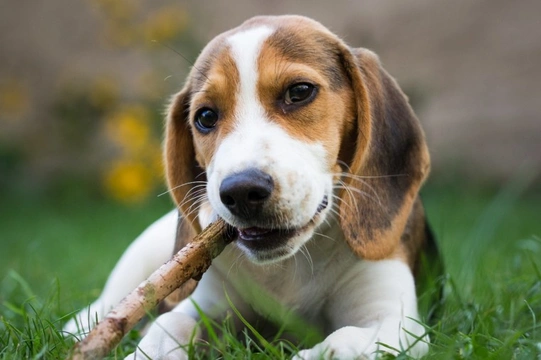
Why Do Dogs Pick Up Sticks? Safe or Not?
Virtually all dogs that enjoy playing fetch or carrying objects in their mouths, such as many Springer Spaniel puppies, have a natural tendency to pick up sticks when toys are not available or even sometimes when they are.
This common behaviour is often so familiar to owners that it goes unquestioned. However, once we consider why dogs like sticks so much, a complex mix of natural instincts, sensory appeal, and learned behaviour emerges. This article explores these factors, the potential safety risks of sticks, and expert recommendations on safe alternatives for play.
The Historical Appeal of Sticks for Dogs
Traditionally, before the modern range of dog toys became widespread, many owners encouraged their dogs to fetch sticks on walks. Sticks were freely available, zero-cost playthings that satisfied dogs’ natural desire to carry and chew. While nowadays many owners provide safe, quality toys, stick play has persisted as a collective behaviour passed down through observation by dogs.
For example, younger dogs often learn to pick up sticks by watching older dogs doing so, thus reinforcing the association between sticks and play. This collective memory explains why even dogs that have never officially been encouraged to play with sticks might still be drawn to them.
What Drives Dogs to Pick Up Sticks?
Several key reasons explain why dogs seek out sticks:
- Instinctual behaviour: Dogs inherit hunting and gathering instincts that draw them to carry items reminiscent of prey or bones.
- Substitute for toys: When their usual toys are missing, lost, or being guarded, dogs might pick up sticks as neutral objects for fetch or chewing.
- Sensory stimulation: The smells, textures, and tactile feel of sticks stimulate dogs’ keen senses, making sticks intriguing and enjoyable objects.
- Chewing needs: Chewing is natural and helps maintain oral health; sticks offer a readily available chew object, especially for teething puppies.
Are All Sticks Equally Appealing to Dogs?
Not all sticks attract dogs equally. Some types are naturally avoided due to their unpleasant taste or potential toxicity. For example, sticks from yew trees tend to be bitter and avoided by dogs. This natural aversion helps protect dogs from certain poisonous woods, though not all toxic sticks have detectable warnings for dogs.
Sticks and Safety: Key Risks to Consider
Despite their appeal, sticks are not safe chew toys for dogs. The main risks include:
- Splinters and mouth injuries: Sticks can break into sharp splinters that injure the mouth, gums, or tongue.
- Choking hazards: Swallowed fragments or large sharp ends can lodge in the throat or digestive tract, causing choking.
- Internal damage: Sharp pieces can pierce internal organs if ingested.
- Toxic contamination: Sticks may carry fungus, mould, toxins, or thorns harmful to dogs.
- Risk during fetch: Running with sticks poses injury risks if dogs slip on pointed sticks or collide with others.
Expert Advice on Safe Alternatives and Responsible Play
Current UK veterinary advice recommends avoiding sticks as chew toys or fetch objects. Instead, provide your dog with safe, durable toys designed to withstand chewing and carrying without breaking into dangerous pieces.
Supervision during outdoor play is essential if your dog tends to pick up sticks. Training your dog to drop sticks on command and redirect their attention to a safer toy can help reduce the risks.
For responsible dog ownership, opting for reputable breeders who promote good behavioural socialisation and providing mental stimulation through safe, appropriate playthings are key steps to a happy, healthy dog.
Summary: Why Dogs Like Sticks and Staying Safe
| Reason Dogs Like Sticks | Potential Safety Risks | Expert Recommendations |
|---|---|---|
| Instinctual carrying and prey drive | Splinters causing mouth injury | Supervise and avoid sticks |
| Appealing smells, textures, and variety | Choking on sharp fragments | Use safe chew toys instead |
| Natural chewing behaviour | Ingestion of toxic plants or fungi | Avoid unknown or toxic wood |
Common Questions Related to Dogs and Sticks
Why do dogs pick up sticks?
Quick Answer: Dogs pick up sticks due to instinctual behaviours, sensory enjoyment, and as substitutes for toys.
Dogs have natural hunting and gathering instincts that encourage carrying objects like sticks. The sensory stimulation of smells and textures also draws them to sticks, and when toys are unavailable or possessed by others, sticks serve as accessible items for play and chewing.
Why do dogs like sticks?
Quick Answer: Dogs like sticks because they offer variety in smell, taste, texture, and provide mental stimulation and physical satisfaction.
The appeal of sticks lies in their uniqueness and the sensory experience they provide. Dogs enjoy exploring different sticks, picking one that suits their preference, which satisfies natural curiosity and chewing urges, essential for oral health and mental engagement.
Are sticks safe for dogs?
Quick Answer: Sticks are generally not safe for dogs because they can splinter, cause injuries, and present choking hazards.
While the natural attraction to sticks is understandable, veterinarians advise against letting dogs play or chew sticks due to the high risk of splinters, mouth injuries, choking, and swallowing toxic substances or sharp fragments that can cause serious health problems.



